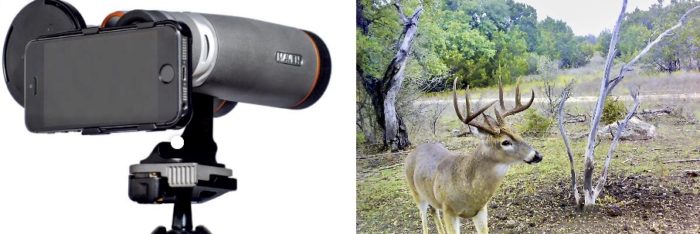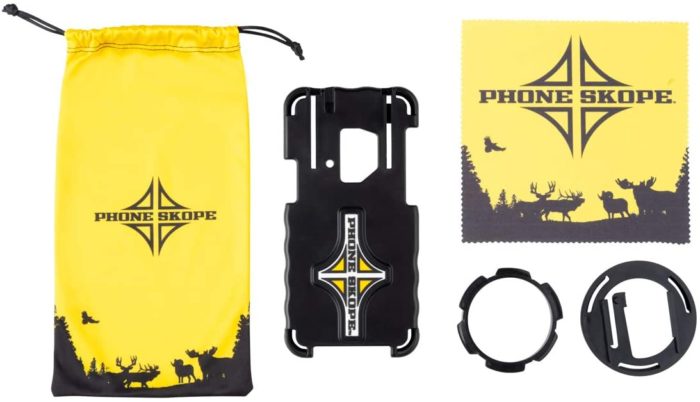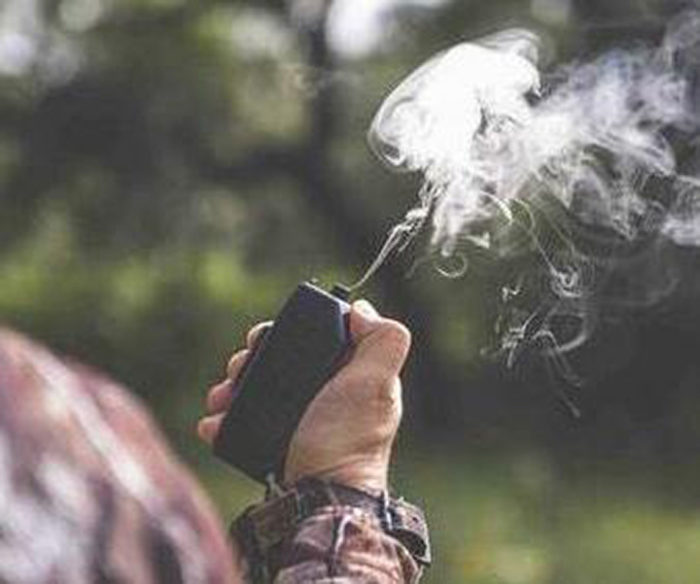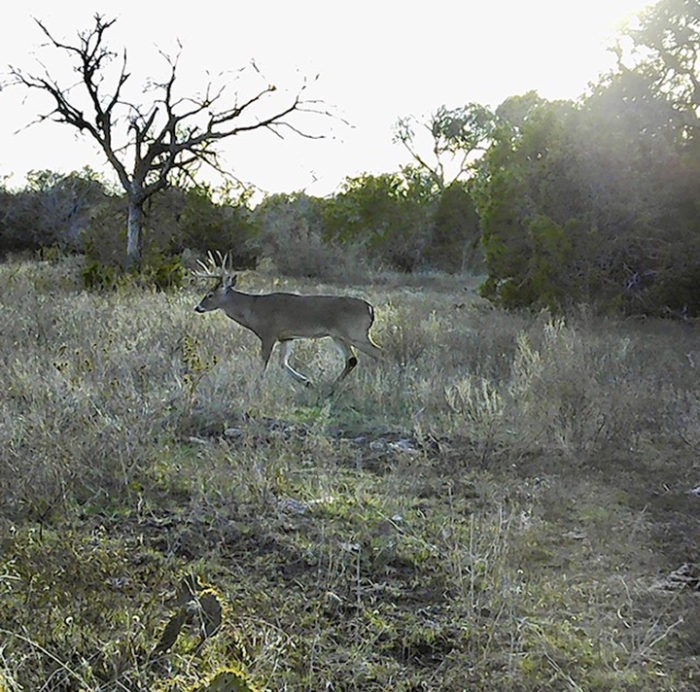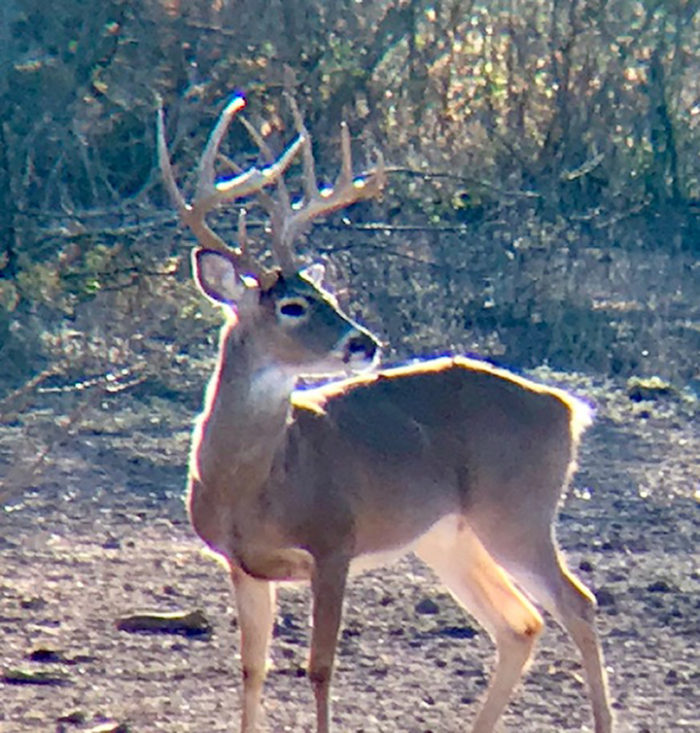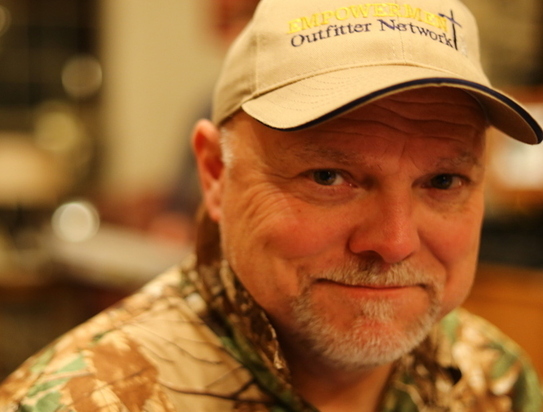The How and Why to Digiscope for Whitetails: The Basics
Ask your average deer hunter, and they will tell you that solid optics are a must. You can have the coolest rifle out there, but if you pair it with a mediocre scope, you’ve taken steps backward. That’s why most deer hunters’ packs are filled with optics that make up a significant portion of their hunting budget.
Drawing distant objects in closer is paramount to success when pursuing whitetails. It’s not reserved for western hunters who need the ability to pull off long-distance stalks. For decades, deer hunters have depended on optics for scouting, and rightly so. For the smart hunters, a great pair of binoculars is akin to a sharp knife or the very weapon they shoot.
Another utility-packed tool is the smartphone. No, it’s not for passing tree stand time playing candy crush. Today’s smartphones are teaming with functionality for the whitetail hunter. For example, they can be linked to trail cameras and offer navigation tools. However, it’s the cameras within that are amazing. I’m talking about the ability to produce extremely clear digital images with filtering capabilities that are off the charts.
The only thing smart phones lack is the ability to bring deer and other wild game in close enough for useful photos and videos. Enter the Phone Skope
Phone Skope kits are custom fit for your brand and model of smartphone and include an adapter to connect it to your optic of choice (brand and model). The result is a sturdy, lightweight, and affordable tool that allows you to take crystal-clear photos at a distance, with no expensive and bulky camera equipment required.
If you’re not already doing it, this season is a great time to add digiscoping to your whitetail hunting arsenal. Here are a few basic steps and tips that might just help you pattern and ultimately down a big mature whitetail buck.
Buy Your Kit
Your first step is to purchase your adaptor kit. While they’re available at Cabela’s and other big box stores, there is no better way to obtain one than online at PhoneSkope.com. Here, you can seamlessly pick your kit based on the brand and model of your device and optics. You can also ask questions and access a lot of practical how-to information.
Upfront Practice
When you receive your kit, it’s imperative to get your bearings. After attaching it to your phone and optics, practice on objects repeatedly. If you have to, start by capturing images in your yard or on your street. Even better, head to more rural spaces and get acclimated. Batches of subpar photos only get you closer to mastering the process.
Assume a steady position, zoom in on fixed objects, take lots of images, and learn.
Don’t Disregard Basic Whitetail Hunting Logic
When it’s time to hit your deer lease, club, or favorite public land grounds to digiscope, remember to employ the basics. Account for wind conditions. As always, the whitetail’s nose is your foe. Whether hunting or scouting, exercise scent control. While you can’t totally account for where deer may come from, don’t throw caution to the wind.
Likewise, stay concealed. Stay tucked away in heavy cover (even take time to create a make-shift blind made from native brush). Pop-up blinds are a great option too. Dress in camo (or at least dark colors).
Remember, you’re on an intel mission.
Advantageous Land Features
Whitetail hunters, especially bowhunters, love to seek out the hot areas where deer typically travel. Treat your digiscoping no differently. Look for sets that have a good view of funnels, food sources, and even known scrapes and rubs. One of the bests areas to capitalize on is stretches between food sources and bedding areas. The idea is to locate and capture shooter bucks. Look for the areas they’re likely to roam. If you’re completely new to the area, concentrate on good concealment, line of sight, and scent control.
Going Steady
Yes, digiscoping draws deer and objects in close. However, it also heightens movement from an unsteady trigger finger or windy conditions. While you can take good photos with your free hand, consider using a brace such as a hunting blind opening or tree branch.
For best results, use a tripod (the heavier the better). Many tripods have a universal ¼-inch receiver that will accept a binocular adaptor. These units come at an array of price points. Even lightweight and inexpensive units go a long way toward minimizing vibration. While they are typically easy to set up, be sure to practice it so it’s fast and easy in the field.
Leveraging Light
No one likes the picture of a majestic mainframe 10-pointer that looks like a blurred basket-rack. With digiscoping, the glare of the sun can be downright inhospitable. Don’t set up directly facing the sun. It’s not a good idea when you hunt, and it’s even worse for digiscoping. If you do, images will be distorted. Great times to digiscope include the early hours of the morning and late afternoon. Overcast days are good as well.
Locking In
When you digiscope, your optics and smartphone are trying to focus at the same time. To combat this, press and hold your finger on your subject on your screen. The screen will respond with “AE/AF Lock.” This will allow you to focus on your target more easily. This effectively disables the autofocus system, giving you good control over exposure and focus. One of the biggest advantages of using the AE/AF lock is when you wish to take multiple images of the same subject, as it doesn’t have to be set for each shot.
After the Shot
When you capture deer via your Phone Skope kit, you have additional ways to enhance the image. There is some filtering ability in the Phone Skope app, your iPhone or Android camera, and outside apps designed for photo enhancement. This will allow you to sharpen or remove the vignette-effect as well as adjust clarity, lighting, shadows, and color. The sky is the limit. I like to use the Phonto app in conjunction with my Phone Skope photos.
Remember to keep practicing. Get comfortable digiscoping in various conditions. At the same time, seek the best circumstances possible. Also, remember that not every picture is going to be a piece of art. And it doesn’t have to be. Oftentimes, as whitetail hunters, the primary goal is to obtain new information about area deer herds. If you get an adequate image of a buck from a large distance, you’ve gained a lot.
On top of the hunting and scouting benefits, the sharing value is priceless. Hardcore whitetail hunters love images of bucks, and sharing with friends and fellow hunters via texting or social media is fun and rewarding.
Based in Texas, Jerald Kopp is President of 1st Light Hunting Journal. His articles cover a variety of topics about hunting and the outdoor lifestyle. Jerald is an avid outdoorsman with deer hunting and whitetails being by far his greatest passion. He was introduced to hunting and fishing at an early age and has been enjoying it for 40+ years. In 2005, he established the Empowerment Outfitter Network (EON) – a faith-based non-profit organization that provides hunting opportunities for disabled and terminally-ill children and youth. When not hunting, he spends his time traveling and enjoying life with Amy, his wife of over 30 years. Jerald and Amy have two adult daughters and a son-in-law.

